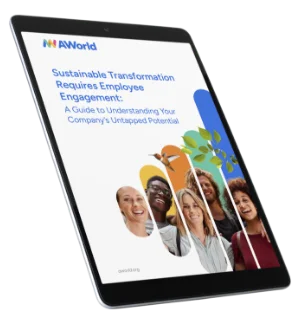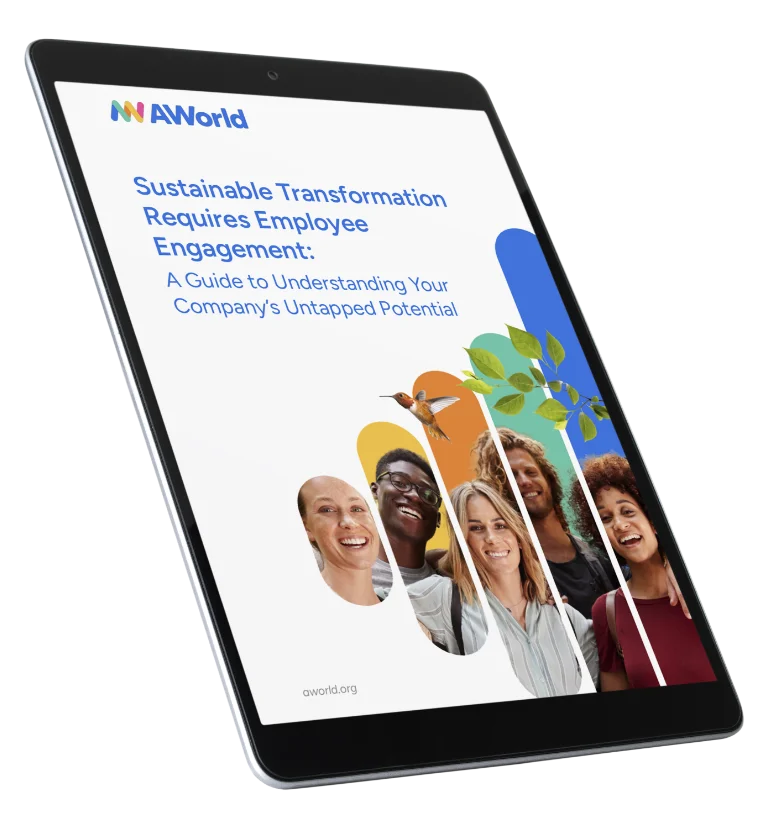Sustainability Performance Management (SPM) refers to a continuous process required to define corporate strategy and objectives in the area of sustainability.
This process begins with the conception of a sustainability strategy, which then paves the way for tangible and implementable initiatives. The next step involves defining precise and measurable goals, which are indispensable for guiding and shaping a company’s efforts, and then evaluating and measuring progress.
But why is Sustainability Performance Management important? And how is it implemented? Continue reading this AWorld article to find out!
Table of Contents
- Why is it important to focus on Sustainable Performance Management?
- How is a Sustainability Performance Management process developed?
- The three dimensions of Sustainability Performance
- Challenge and obstacles in Sustainability Performance Management
- KPIs and reporting in Sustainability Performance Management
- How to boost the Sustainable Improvement Process?
- AWorld Case Study: Cognizant
Why is it important to focus on Sustainable Performance Management?
Sustainable Performance Management integrates and contributes positively to the overall corporate strategy, ensuring that sustainability is not treated as an isolated effort, but as a fundamental component of the company’s long-term vision and operations. Here are the main benefits:
- Alignment with corporate strategy
SPM ensures that a company’s sustainability initiatives are deeply integrated into the overall corporate strategy. This means that sustainability is taken into account in every business decision.
- Risk mitigation and compliance
By focusing on sustainable practices, a company can proactively identify and mitigate various risks, including environmental, social and governance (ESG) risks. This proactive approach helps anticipate regulatory changes and ensure compliance with environmental laws and standards, reducing the likelihood of fines and legal problems.
- Long-term financial performance
As we know, sustainable companies tend to perform better financially in the long term. By adopting sustainable practices, a company can reduce costs, access new markets and attract investment from socially responsible investors.
- Improving brand reputation and customer loyalty
Consumers are increasingly aware of environmental and social issues. Companies that demonstrate their commitment to sustainability improve their brand perception and foster greater loyalty.
- Employee involvement and attraction
A focus on sustainability can lead to higher levels of employee engagement, improved morale and greater ease in attracting top talent.
- Long-term resilience
By incorporating sustainability into its strategy, a company is more likely to adapt to a changing world. For example, it is more resilient to external shocks, such as resource scarcity or changes in consumer preferences, because it is already working to anticipate and adapt to these changes.
- Positive social and environmental impact
Adopting a sustainable approach has a positive impact on society and the environment. Companies that focus on Sustainability Performance Management contribute to solving global challenges such as climate change, inequality and biodiversity loss.
How is a Sustainability Performance Management process developed?
Initiating a Sustainability Performance Management process, a company must follow a structured approach. According to Deloitte, this approach must be based on four main pillars to ensure that sustainability is fully integrated into business operations.
- Define priorities and objectives
The process must begin with the definition of sustainability priorities and goals. This involves identifying the most relevant sustainability issues for the company and setting measurable goals that are aligned with the corporate strategy. At this stage, for example, a company may decide to reduce CO2 emissions by 50% by 2030.
- Providing visibility
Sustainability must be a visible part of corporate culture and operations. This means making sure that sustainability goals and progress are shared with all company stakeholders. Following the example of CO2 emissions, at this stage a company can decide to release information on its emissions every month.
- Developing a plan
Once targets have been set and visibility ensured, the next step is to develop a plan for achieving sustainability goals. This plan should include identifying the necessary resources, assigning responsibilities and setting deadlines. At this stage, a company could explore decarbonisation paths to reduce its carbon footprint.
- Defining structural measures
The last step involves the identification of structural measures to ensure that the sustainability strategy is effectively implemented and continuously improved. This includes setting up systems for data collection and analysis, establishing governance structures to oversee sustainability efforts, and implementing policies and procedures that incorporate sustainability into day-to-day business practices. Finally, at this stage, a company may implement internal carbon tariffs as part of its financial planning processes.
The three dimensions of Sustainability Performance
Sustainability Performance Management is intrinsically linked to the concept of the Triple Bottom Line, which emphasises the three essential dimensions of sustainability: environmental, social and economic. This framework forms the basis of the holistic approach to sustainability, which ensures that an organisation’s operations have a positive impact not only financially, but also on the environment and society. These three interconnected dimensions form the cornerstone of a comprehensive sustainability strategy.
- Environmental dimension
Environmental sustainability aims to protect the natural world. This dimension therefore involves the reduction of negative environmental impacts, such as carbon emissions, waste and pollution, while promoting the conservation of natural resources.
- Social Dimension
Social sustainability focuses on the human aspect of an organisation’s operations. It includes ensuring fair and equitable treatment of employees, promoting diversity and inclusion, safeguarding human rights and contributing positively to community development.
- Economic dimension
Economic sustainability goes beyond mere profitability to include the financial implications of business practices on society and the environment. It is about ensuring the economic viability of the organisation, taking into account the long-term effects of business activities on the environment and society.
Challenge and obstacles in Sustainability Performance Management
Sustainability Performance Management entails several challenges and obstacles for a company. Some of the most noteworthy include:
- Integration into the core business strategy
One of the biggest challenges is to integrate sustainability into the core business strategy, rather than treating it as a separate or secondary issue. This requires a change of mindset at all levels of the organisation to ensure that sustainability is taken into account in every business decision and operation.
- Data collection and analysis
Accurately collecting, managing and analysing sustainability data is not easy. Companies often have to contend with the lack of standardised metrics and the difficulty of quantifying certain aspects of sustainability, such as social impact.
- Balancing short-term pressures with long-term goals
Companies are often pressured for short-term financial results, which can conflict with the long-term nature of sustainability initiatives. Balancing these short-term demands with the need for long-term sustainable growth is a major challenge.
- Change management
Embedding sustainability in a company requires significant cultural change, as it involves changes in attitudes, behaviour and practices at all levels, and may encounter resistance.
- Regulatory compliance and maintaining standards
The sustainability regulatory landscape is constantly evolving and companies must keep up with new regulations and standards. Compliance can be a challenge, especially for companies operating in multiple jurisdictions with different regulations.
- Financial constraints
Implementing sustainability initiatives often requires significant upfront investments. Demonstrating the financial sustainability of these initiatives can be challenging, especially for smaller organisations or industries with low margins.
- Stakeholder involvement and expectations
Another major challenge is the effective involvement of internal and external stakeholders, as well as managing their expectations. Each group may have different expectations and demands regarding sustainability.
- Impact measurement and reporting
Effectively measuring the impact of sustainability initiatives and transparently reporting results to stakeholders can be a challenge. Organisations need to establish robust reporting mechanisms and be transparent about both successes and areas for improvement.
KPIs and reporting in Sustainability Performance Management
In Sustainability Performance Management, the monitoring of KPIs is crucial. Both environmental, social and economic aspects must be included. Environmental KPIs include metrics such as carbon footprint, energy consumption, water use and waste management; social KPIs focus on employee satisfaction and engagement, diversity and inclusion, health and safety, and impact on local communities. Economic KPIs, on the other hand, typically focus on financial performance, investment in sustainable practices, and management of risks related to environmental and social issues.
In order to effectively monitor and report on these KPIs, companies need to implement robust data collection systems, which can range from specialised software to IoT devices for real-time monitoring. Established sustainability reporting schemes such as the Global Reporting Initiative (GRI), the Sustainability Accounting Standards Board (SASB) or the Task Force on Climate-related Financial Disclosures (TCFD) can be adopted.
The information gained from this monitoring and reporting process is valuable and enables decisions to be made to continuously improve sustainability performance. With this integrated approach, companies can effectively monitor their sustainability progress and demonstrate their commitment to a wide range of stakeholders, including investors, customers and employees.
How to boost the Sustainable Improvement Process?
Facilitating sustainable improvement necessitates a comprehensive approach that actively involves both employees and stakeholders. For employee engagement enhancement, a focus on training and awareness is pivotal, ensuring that every team member comprehends the significance of sustainability and their contribution potential. Effective methods to foster this awareness encompass organising workshops, seminars, and recurrent events centred around sustainability. Additionally, the introduction of incentive programs recognizing and rewarding employees for significant contributions to sustainability objectives can substantially promote a sustainable organisational culture.
Meanwhile, enhancing stakeholder engagement requires a profound understanding of the sustainability interests and concerns pertinent to each stakeholder group. This, in turn, involves regular communication through diverse channels, such as reports, newsletters, and social media, to keep stakeholders abreast of ongoing sustainability initiatives and progress updates.
AWorld Case Study: Cognizant
Cognizant, a major global company, embarked on an innovative sustainability initiative using the AWorld platform to enhance its sustainability efforts. The goal was ambitious: to involve employees and collaborators in the realisation of 200,000 positive actions for the planet, thus strengthening the company’s sustainable profile.
The goal of the challenge, which was set to last three months, was achieved in just 17 days, a testament to the commitment and involvement of Cognizant’s employees. Over 15,000 users, with an involvement rate of 89%, joined the team, working collectively to achieve this sustainability goal.
But the success did not stop there. At the end of three months, the initial target was not only reached, but more than doubled. The final tally reached the impressive figure of 782,000 positive actions for the planet. These actions resulted in a significant reduction in environmental impact: saving 3.3 million kilograms of CO2 emissions, 1.1 million kWh of electricity and 141 million litres of water. The results were not only a triumph in terms of numbers, but also in the magnitude of the impact, contributing to several Sustainable Development Goals (SDGs).
This case study is an excellent example of how digital platforms such as AWorld can be extremely useful and effective in Sustainability Performance Management.
By engaging employees in a clear, measurable and impactful challenge, Cognizant was able to significantly advance its sustainability program. The success of the initiative highlights the power of collective action and employee engagement in driving substantial environmental change. It also demonstrates how sustainability goals can be integrated into the corporate culture, encouraging shared responsibility and commitment to environmental stewardship by the workforce.





